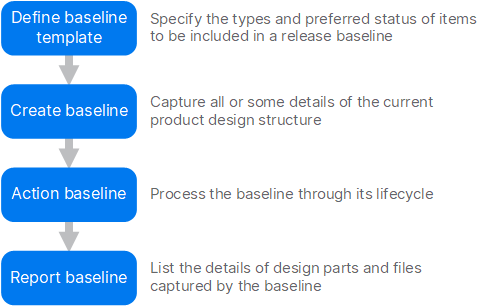Baseline management
At product development milestones, you can capture and record item versions contained in a design part or a project/stream by saving them as a baseline.
Baseline types and templates
A baseline is a snapshot of a design part or a project/stream at a particular point in time.
Typically, baselines are used to freeze a configuration within a project/stream for test, integration, build, or release purposes. You can also use them to meet the audit requirements for DOD-2167A, ISO9000, SEI Level accreditation, and contractual commitments to milestone payments.
You can create baselines using a rich set of filtering criteria, including design part, item type, and status. You can also create baselines based on requests.
When you create a baseline, Dimensions CM records the status of all items included in it, ensuring that they can be reliably recreated. All items in a baseline are preserved for future use, such as rebuilding the entire configuration or providing the basis for a new maintenance release.
A baseline type defines the attributes and lifecycle of the baseline. For details about available types, see Baseline categories.
The status of a baseline reflects the status of the configuration as a whole, for example, PASSED TEST, FAILED TEST, or READY FOR RELEASE. It provides important management information on the progress of the project/stream.
A baseline template is a set of rules that determine which items to include or exclude in a baseline, either based on the item type, revision, status, and relationships, or alternatively based on a group of Dimensions CM requests to which items are related.
Example: If you include a baseline template rule *FINAL (latest edit revision at final lifecycle state) for the SRC item type, it means that you want to include only those revisions of SRC items in your project/stream that have reached the Approved state.
A baseline template can have multiple baseline rules, and you can set different rules for different item types.
Baseline types and templates are defined in the Administration Console.
Work with baselines
Typically, you follow this process when working with baselines:

For details about reports, see Reports and published views.
In Dimensions CM, you can perform the following baseline operations:
| View baseline items | View the items included in a baseline. |
| View users, roles, and privileges | View the role assignments and privileges for a baseline, and the users who have the baseline in their inboxes. |
| View baseline history |
View the action and update history of a baseline. Desktop client only: You can also view baseline pedigree, which displays the objects related to the baseline. |
| Action baselines | Move baselines from one state in the lifecycle to the next state. Move the items in a baseline from one state to another. |
| Edit attributes | Change a baseline's attributes. |
| Create baselines | Create a new baseline from a project/stream or a design part. |
| Create revised baselines and merged baselines | Use existing release baselines to create revised and merged baselines. |
| Delete baselines | Delete a baseline that was created prematurely or is no longer needed. |
Baseline lifecycles
Baselines have lifecycles that are determined by the baseline type. Each baseline type can have a different lifecycle.
The status of a baseline reflects the status of the configuration as a whole, for example, Passed Testing, Failed Testing, or Ready for Release. It provides important management information on the progress of the project/stream.
The administrator uses the Administration Console to define the lifecycle and the roles that move the baseline from one state to another. Roles are assigned to Dimensions CM users, enabling them to action the baseline to each state in the lifecycle.
The following diagram provides an example of a typical baseline lifecycle.

Users with the appropriate roles can action the baseline along the lifecycle. With each completed action, an email message is sent to the user with the next role in the lifecycle, and the baseline is added to the user's Baselines inbox.
Baseline relationships
A baseline can have the following relationships with other Dimensions CM objects.
| Object | Description |
|---|---|
| Items | The baseline contains a list of item revisions and their status at the time of the revision. Items can be in more than one baseline. |
| Design parts | The baseline contains a list of the design parts and their status in the baseline. |
| Releases and customers | A baseline can be used as the basis for a release when it is released to an external or internal customer. The release may also be related to specific customers to record who the release went to. |
| Projects/Streams | The baseline has a Based on relationship to the project/stream from which it was created. It can also have an Used by relationship to a project/stream when it is used as a child collection of items within that project/stream. |
| Requests | A baseline can have an Affected, In Response To, or Info relationship to one or more requests. |
| Baselines | A release baseline has relationships to the baselines that were used to create it during a merge operation. |
 See also:
See also:
- Web client: Manage baselines
- Desktop client: Manage baselines












